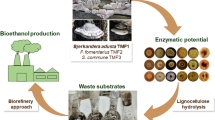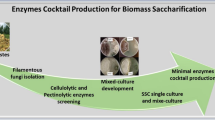Abstract
The endophytic fungi represent a potential source of microorganisms for enzyme production. However, there have been only few studies exploiting their potential for the production of enzymes of industrial interest, such as the (hemi)cellulolytic enzymatic cocktail required in the hydrolysis of lignocellulosic biomass. Here, a collection of endophytic fungi isolated from mangrove tropical forests was evaluated for the production of carbohydrolases and performance on the hydrolysis of cellulose. For that, 41 endophytic strains were initially screened using a plate assay containing crystalline cellulose as the sole carbon source and the selected strains were cultivated under solid-state fermentation for endoglucanase, β-glucosidase, and xylanase enzyme quantification. The hydrolysis of a cellulosic material with the enzymes from endophytic strains of the Aspergillus genus resulted in glucose and conversion values more than twofold higher than the reference strains (Aspergillus niger F12 and Trichoderma reesei Rut-C30). Particularly, the enzymes from strains A. niger 56 (3) and A. awamori 82 (4) showed a distinguished saccharification performance, reaching cellulose conversion values of about 35% after 24 h. Linking hydrolysis performance to the screening steps played an important role towards finding potential fungal strains for producing enzymatic cocktails with high saccharification efficiency. These results indicate the potential of mangrove-associated endophytic fungi for production of carbohydrolases with efficient performance in the hydrolysis of biomass, thus contributing to the implementation of future biorefineries.




Similar content being viewed by others
References
Moshkelani, M., Marinova, M., Perrier, M., & Paris, J. (2013). The forest biorefinery and its implementation in the pulp and paper industry: energy overview. Applied Thermal Engineering, 50, 1427–1436.
Sheldon, R. A. (2014). Green and sustainable manufacture of chemicals from biomass: state of the art. Green Chemistry, 16, 950–963.
Kamm, B., & Kamm, M. (2004). Principles of biorefineries. Applied Microbiology and Biotechnology, 64, 137–145.
Mohan, S. V., Nikhil, G. N., Chiranjeevi, P., Reddy, C. N., Rohit, M. V., Kumar, A. N., & Sarkar, O. (2016). Waste biorefinery models towards sustainable circular bioeconomy: critical review and future perspectives. Bioresource Technology, 215, 2–12.
Klein-Marcuschamer, D., Oleskowicz-Popiel, P., Simmons, B. A., & Blanch, H. W. (2012). The challenge of enzyme cost in the production of lignocellulosic biofuels. Biotechnology and Bioengineering, 109, 1083–1087.
Johnson, E. (2016). Integrated enzyme production lowers the cost of cellulosic ethanol. Biofuels Bioproducts & Biorefining-Biofpr, 10, 164–174.
Liu, G., Zhang, J., & Bao, J. (2016). Cost evaluation of cellulase enzyme for industrial-scale cellulosic ethanol production based on rigorous Aspen Plus modeling. Bioprocess and Biosystems Engineering, 39, 133–140.
Delabona, P., Farinas, C., da Silva, M., Azzoni, S., & Pradella, J. (2012). Use of a new Trichoderma harzianum strain isolated from the Amazon rainforest with pretreated sugar cane bagasse for on-site cellulase production. Bioresource Technology, 107, 517–521.
Cunha, F. M., Vasconcellos, V. M., Florencio, C., Badino, A. C., & Farinas, C. S. (2017). On-site production of enzymatic cocktails using a non-conventional fermentation method with agro-industrial residues as renewable feedstocks. Waste and Biomass Valorization, 8, 517–526.
Pinto Braga, C. M., PdS, D., DJdS, L., Alvaredo Paixao, D. A., da Cruz Pradella, J. G., & Farinas, C. S. (2014). Addition of feruloyl esterase and xylanase produced on-site improves sugarcane bagasse hydrolysis. Bioresource Technology, 170, 316–324.
Florencio C., Couri S., Farinas C.S. Correlation between agar plate screening and solid-state fermentation for the prediction of cellulase production by Trichoderma strains. In Enzyme Research. https://doi.org/10.1155/2012/793708
Kovacs, K., Macrelli, S., Szakacs, G., & Zacchi, G. (2009). Enzymatic hydrolysis of steam-pretreated lignocellulosic materials with Trichoderma atroviride enzymes produced in-house. Biotechnology for Biofuels, 2, 11.
Rodriguez-Zuniga, U. F., Couri, S., Neto, V. B., Crestana, S., & Farinas, C. S. (2013). Integrated strategies to enhance cellulolytic enzyme production using an instrumented bioreactor for solid-state fermentation of sugarcane bagasse. Bioenergy Research, 6, 142–152.
Florencio, C., Cunha, F. M., Badino, A. C., & Farinas, C. S. (2015). Validation of a novel sequential cultivation method for the production of enzymatic cocktails from Trichoderma strains. Applied Biochemistry and Biotechnology, 175, 1389–1402.
Payne, C. M., Knott, B. C., Mayes, H. B., Hansson, H., Himmel, M. E., Sandgren, M., Stahlberg, J., & Beckham, G. T. (2015). Fungal Cellulases. Chemical Reviews, 115, 1308–1448.
Horn S.J., Vaaje-Kolstad G., Westereng B., Eijsink V.G.H. (2012). Novel enzymes for the degradation of cellulose. Biotechnology for Biofuels. https://doi.org/10.1186/1754-6834-5-45
Lynd, L., Weimer, P., van Zyl, W., & Pretorius, I. (2002). Microbial cellulose utilization: fundamentals and biotechnology. Microbiology and Molecular Biology Reviews, 66, 506-+.
van den Brink, J., & de Vries, R. P. (2011). Fungal enzyme sets for plant polysaccharide degradation. Applied Microbiology and Biotechnology, 91, 1477–1492.
Makela, M. R., Donofrio, N., & de Vries, R. P. (2014). Plant biomass degradation by fungi. Fungal Genetics and Biology, 72, 2–9.
Benocci, T., Aguilar-Pontes, M. V., Zhou, M., Seiboth, B., & de Vries, R. P. (2017). Regulators of plant biomass degradation in ascomycetous fungi. Biotechnology for Biofuels, 10, 25.
Farinas, C. S. (2015). Developments in solid-state fermentation for the production of biomass-degrading enzymes for the bioenergy sector. Renewable & Sustainable Energy Reviews, 52, 179–188.
Florencio, C., Cunha, F. M., Badino, A. C., Farinas, C. S., Ximenes, E., & Ladisch, M. R. (2016). Secretome analysis of Trichoderma reesei and Aspergillus niger cultivated by submerged and sequential fermentation processes: Enzyme production for sugarcane bagasse hydrolysis. Enzyme and Microbial Technology, 90, 53–60.
King, B. C., Waxman, K. D., Nenni, N. V., Walker, L. P., Bergstrom, G. C., & Gibson, D. M. (2011). Arsenal of plant cell wall degrading enzymes reflects host preference among plant pathogenic fungi. Biotechnology for Biofuels, 4, 14.
Delabona, P. D., Cota, J., Hoffmam, Z. B., Paixao, D. A. A., Farinas, C. S., Cairo, J., Lima, D. J., Squina, F. M., Ruller, R., & Pradella, J. G. D. (2013). Understanding the cellulolytic system of Trichoderma harzianum P49P11 and enhancing saccharification of pretreated sugarcane bagasse by supplementation with pectinase and alpha-L-arabinofuranosidase. Bioresource Technology, 131, 500–507.
Robl, D., Delabona, P. D., Mergel, C. M., Rojas, J. D., Costa, P. D., Pimentel, I. C., Vicente, V. A., Pradella, J. G. D., & Padilla, G. (2013). The capability of endophytic fungi for production of hemicellulases and related enzymes. BMC Biotechnology, 13, 12.
Souza, D. T., Bispo, A. S. R., Bon, E. P. S., Coelho, R. R. R., & Nascimento, R. P. (2012). Production of thermophilic endo-beta-1,4-xylanases by Aspergillus fumigatus FBSPE-05 using agro-industrial by-products. Applied Biochemistry and Biotechnology, 166, 1575–1585.
Doria, E., Altobelli, E., Girometta, C., Nielsen, E., Zhang, T., & Savino, E. (2014). Evaluation of lignocellulolytic activities of ten fungal species able to degrade poplar wood. International Biodeterioration & Biodegradation, 94, 160-+.
Sebastianes, F. L. D., RomaO-Dumaresq, A. S., Lacava, P. T., Harakava, R., Azevedo, J. L., de Melo, I. S., & Pizzirani-Kleiner, A. A. (2013). Species diversity of culturable endophytic fungi from Brazilian mangrove forests. Current Genetics, 59, 153–166.
Liu, J., Wang, X. C., HM, P., Liu, S., Kan, J., & Jin, C. H. (2017). Recent advances in endophytic exopolysaccharides: production, structural characterization, physiological role and biological activity. Carbohydrate Polymers, 157, 1113–1124.
Correa, R. C. G., Rhoden, S. A., Mota, T. R., Azevedo, J. L., Pamphile, J. A., de Souza, C. G. M., Polizeli, M., Bracht, A., & Peralta, R. M. (2014). Endophytic fungi: expanding the arsenal of industrial enzyme producers. Journal of Industrial Microbiology & Biotechnology, 41, 1467–1478.
Sebastianes, F. L. S., Azevedo, J. L., & Lacava, P. T. (2017). Diversity and biotechnological potential of endophytic microorganisms associated with tropical mangrove forests. Switzerland: Springer Nature.
Dezam, A. P. G., Vasconcellos, V. M., Lacava, P. T., & Farinas, C. S. (2017). Microbial production of organic acids by endophytic fungi. Biocatalysis and Agricultural Biotechnology., 11, 282–287.
Liu, Y. Y., Chen, S. H., Liu, Z. M., Lu, Y. J., Xia, G. P., Liu, H. J., He, L., & She, Z. G. (2015). Bioactive metabolites from mangrove endophytic fungus Aspergillus sp 16-5B. Marine Drugs, 13, 3091–3102.
Farinas, C. S., Loyo, M. M., Baraldo Junior, A., Tardioli, P. W., Bertucci Neto, V., & Couri, S. (2010). Finding stable cellulase and xylanase evaluation of the synergistic effect of pH and temperature. New Biotechnology, 27, 810–815.
Ghose, T. K. (1987). Measurement of cellulase activities. Pure & Appl. Chem., 59, 257–268.
Bailey, M. J., & Poutanen, K. (1989). Production of xylanolytic enzymes by strains of Aspergillus. Applied Microbiology and Biotechnology, 30, 5–10.
Miller, G. (1959). Use of dinitrosalicylic acid reagent for determination of reducing sugar. Analytical Chemistry, 31, 426–428.
Zhang, Y., Himmel, M., & Mielenz, J. (2006). Outlook for cellulase improvement: screening and selection strategies. Biotechnology Advances, 24, 452–481.
de Vries, R. P., & Visser, J. (2001). Aspergillus enzymes involved in degradation of plant cell wall polysaccharides. Microbiology and Molecular Biology Reviews, 65, 497-+.
Delabona, P. D., Pirota, R., Codima, C. A., Tremacoldi, C. R., Rodrigues, A., & Farinas, C. S. (2013). Effect of initial moisture content on two Amazon rainforest Aspergillus strains cultivated on agro-industrial residues: biomass-degrading enzymes production and characterization. Industrial Crops and Products, 42, 236–242.
Sorensen, A., Teller, P. J., Lubeck, P. S., & Ahring, B. K. (2011). Onsite enzyme production during bioethanol production from biomass: screening for suitable fungal strains. Applied Biochemistry and Biotechnology, 164, 1058–1070.
Rodriguez-Zuniga, U., Farinas, C., Neto, V., Couri, S., & Crestana, S. (2011). Aspergillus niger production of cellulases by solid-state fermentation. Pesquisa Agropecuaria Brasileira, 46, 912–919.
Gusakov, A. V. (2011). Alternatives to Trichoderma reesei in biofuel production. Trends in Biotechnology, 29, 419–425.
Vasconcellos, V. M., Tardioli, P. W., Giordano, R. L. C., & Farinas, C. S. (2015). Production efficiency versus thermostability of (hemi)cellulolytic enzymatic cocktails from different cultivation systems. Process Biochemistry, 50, 1701–1709.
Pirota, R., Tonelotto, M., Delabona, P. D., Fonseca, R. F., Paixao, D. A. A., Baleeiro, F. C. F., Neto, V. B., & Farinas, C. S. (2013). Enhancing xylanases production by a new Amazon forest strain of Aspergillus oryzae using solid-state fermentation under controlled operation conditions. Industrial Crops and Products, 45, 465–471.
Rodriguez-Zuniga, U. F., Neto, V. B., Couri, S., Crestana, S., & Farinas, C. S. (2014). Use of spectroscopic and imaging techniques to evaluate pretreated sugarcane bagasse as a substrate for cellulase production under solid-state fermentation. Applied Biochemistry and Biotechnology, 172, 2348–2362.
Delabona, P., Pirota, R., Codima, C., Tremacoldi, C., Rodrigues, A., & Farinas, C. (2012). Using Amazon forest fungi and agricultural residues as a strategy to produce cellulolytic enzymes. Biomass & Bioenergy, 37, 243–250.
Florencio, C., Badino, A. C., & Farinas, C. S. (2016). Soybean protein as a cost-effective lignin-blocking additive for the saccharification of sugarcane bagasse. Bioresource Technology, 221, 172–180.
Cunha, F. M., Badino, A. C., & Farinas, C. S. (2017). Effect of a novel method for in-house cellulase production on 2G ethanol yields. Biocatalysis and Agricultural Biotechnology, 9, 224–229.
Singhania, R. R., Patel, A. K., Sukumaran, R. K., Larroche, C., & Pandey, A. (2013). Role and significance of beta-glucosidases in the hydrolysis of cellulose for bioethanol production. Bioresource Technology, 127, 500–507.
de Giuseppe, P. O., Souza, T., Souza, F. H. M., Zanphorlin, L. M., Machado, C. B., Ward, R. J., Jorge, J. A., Furriel, R. D. M., & Murakami, M. T. (2014). Structural basis for glucose tolerance in GH1 beta-glucosidases. Acta Crystallographica Section D-Biological Crystallography, 70, 1631–1639.
Longoni, P., Rodolfi, M., Pantaleoni, L., Doria, E., Concia, L., Picco, A. M., & Cella, R. (2012). Functional analysis of the degradation of cellulosic substrates by a Chaetomium globosum endophytic isolate. Applied and Environmental Microbiology, 78, 3693–3705.
Acknowledgments
The authors would like to thank Embrapa, CNPq (Process 401182/2014-2), CAPES, and FAPESP (Process 2004/13910-6, 2006/57060-1, 2014/19000-3, and 2016/10636-8) (all from Brazil) for their financial support.
Author information
Authors and Affiliations
Corresponding author
Ethics declarations
Competing Interests
The authors declare they have no competing interests.
Rights and permissions
About this article
Cite this article
Maroldi, M.M.C., Vasconcellos, V.M., Lacava, P.T. et al. Potential of Mangrove-Associated Endophytic Fungi for Production of Carbohydrolases with High Saccharification Efficiency. Appl Biochem Biotechnol 184, 806–820 (2018). https://doi.org/10.1007/s12010-017-2590-5
Received:
Accepted:
Published:
Issue Date:
DOI: https://doi.org/10.1007/s12010-017-2590-5




